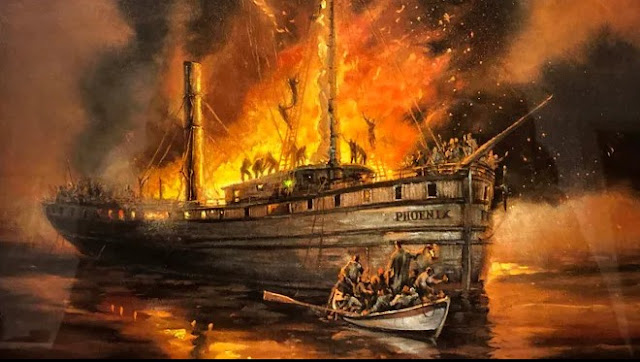The bottom line of this historical highway marker claims the sign was placed there in 1956. I was nine years old. As I remember, it was south and east of town, closer to Cedar Grove than it was to Oostburg, along what was once state highway 141, but what has been blessed today with a more historical name--the Sauk Trail.
Some Sauk, some Fox, some Pottawatomi, some Ho-Chunk or Winnebago--they were all there on the lakeshore in 1847, at least remnants thereof, most of them by that time reduced to begging, indigents, according to my great-grandfather's obituary, victims of a rapacious western movement of Euro-Americans, many of them, like my ancestors, immigrants.
The first book I owned I bought from Prange's Department Store in Sheboygan. Most likely, that was close to 1956. That coffee-table sized book cost all of three dollars, I think, but it documented and described Indians, Native Americans, not just the tribes that were on Wisconsin's Lake Michigan shoreline, where I grew up, but all kinds of Indians. I loved it. Paid for it myself--I think my parents were proud really.
I never forgot the highway sign. Mom and Dad likely piled their kids in the car--an old Mercury--and went south down the highway, maybe on our way to Milwaukee, when Dad spotted that flashy new highway marker he'd read about and decided to pull over.
I'm almost positive no school class ever taught me anything about the Phoenix disaster. When I was a boy in the Christian school, there were only two histories that really counted much: national history (the Tea Party, Washington on the Delaware) and Reformation history (Luther, Calvin, Knox, etc.). When I was a kid, I don't know if any teacher I ever had considered Sheboygan County history to be history at all.
All I ever knew of the Phoenix disaster was from this sign. No one talked much about it as I remember, and while there were many in local communities who could trace their ancestry back to some long-gone Phoenix disaster survivor, I couldn't, nor did I lose a relative that cold November night in 1847.
But the story stayed with me, found a permanent place in my heart and soul, and when first I was given the assignment to write a short story--I was a sophomore in college--the very first story I wrote was something about the Phoenix disaster.
Close to 300 Dutch emigrants had left the Netherlands months before, bound for rural Sheboygan County, Wisconsin. They'd boarded the steamship Phoenix for the last leg of the journey, stopped for a time, just north at Manitowoc, then departed, middle of the night, for the Sheboygan harbor. They were within sight of the city lights--that close!--when a boiler blew and set the wooden ship aflame. Most of those on board had one last choice--to drown or burn. The lifeboats were a joke. Who on earth cared for these people, after all? They were just a bunch of lousy immigrants.
When, a few years later, I decided to try to gather a sense of my own roots (Alex Haley, Roots), I started on my very first book project. It was 1976. I was a college teacher. My idea?--to read local histories of Dutch Reformed areas, find stories I liked, and try to write them to learn to write fiction.
The first story I wrote with that collection of stories in mind was the story of the Phoenix disaster. In a way, ever since I was nine, ever since I read that highway sign, I couldn't help but think that somehow, for someone like me, a kid with a Dutch name, who grew up on the lakeshore, that story in some mysterious way belonged to me.
A story in yesterday's Sheboygan Press claims that a local scavenger took a State Historical Society diver along to look over what he'd considered a log when he'd earlier taken a Dutch researcher to the place, a couple miles out, north of Sheboygan, where the Phoenix was thought to have gone down. The expert now claims that the log is not a log, but a smokestack, almost assuredly from the Phoenix. It's been lying there in cold Lake Michigan waters for 175 years. Amazing!--and wonderful.
I just hope some kid in the neighborhood will take notice of all of this, do a little homework on the story, and then allow it a permanent place in the library of his or her soul, which is where you'll find mine.
The story of the Phoenix disaster is bigger and broader, deeper and wider, than even a Lake Michigan horizon at dawn. It begs unanswerable questions, critiques our prejudices, puts us into the kind of stillness that reminds us to think eternally.
__________________________
The story "The Heritage of These Many Years" appears in my first book, Sign of a Promise and Other Stories, 1979.



3 comments:
I've read of it before. Interesting. Happy Thanksgiving
The sign is on hwy LL just outside of Cedar Grove. There is a cemetery East of the sign near the Lake that was known as Indian Cemetery, now know as Amsterdam Cemetery. We were told that people from the Phoenix were buried there.
I've been to the "Indian cemetery" before it was kept up and since, but I've never heard that story before--that some of the deceased were buried there. Certainly is a possibility. Thanks.
Post a Comment